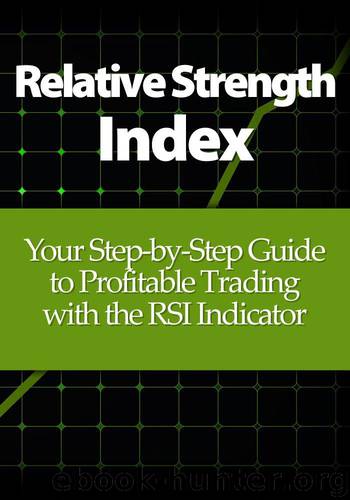Relative Strength Index: Your Step-by-Step Guide to Profitable Trading with the RSI Indicator

Author:Alton Swanson
Language: eng
Format: mobi
Published: 2014-08-31T23:00:00+00:00
Additional Things to Understand about RSI
There are several other things to understand about RSI:
• First, if the price rises every day during the period, then AvgD becomes 0. In this case, dividing AvgU by AvgD leads to an undefined result (division by 0). In this case, RSI is defined to be 100.
• Second, while the easiest and most common method of calculating RSI involves taking simple moving averages, some variants use exponential moving averages. There is also a special averaging approach called Wilder’s Smoothing Method that is similar to an exponential moving average but uses a different smoothing factor. This was invented by the creator of the RSI indicator and is named after him.
• Third, RSIs are not just calculated over 9-day periods. They can in principle be calculated over any period – for instance, an RSI calculated over 9 days is referred to as RSI 9, whereas one calculated over 14 days is referred to as RSI 14. In general, the longer the period, the more slowly the indicator responds to changes in price direction and momentum. RSI 14 is the most common look-back period and is the default on most trading workstations.
Download
This site does not store any files on its server. We only index and link to content provided by other sites. Please contact the content providers to delete copyright contents if any and email us, we'll remove relevant links or contents immediately.
Bad Blood by John Carreyrou(6466)
Rich Dad Poor Dad by Robert T. Kiyosaki(6306)
Principles: Life and Work by Ray Dalio(6110)
Playing to Win_ How Strategy Really Works by A.G. Lafley & Roger L. Martin(5715)
Management Strategies for the Cloud Revolution: How Cloud Computing Is Transforming Business and Why You Can't Afford to Be Left Behind by Charles Babcock(4486)
The Confidence Code by Katty Kay(4146)
Thinking in Bets by Annie Duke(4112)
American Kingpin by Nick Bilton(3699)
Delivering Happiness by Tony Hsieh(3324)
Project Animal Farm: An Accidental Journey into the Secret World of Farming and the Truth About Our Food by Sonia Faruqi(3133)
The Power of Habit by Charles Duhigg(3004)
The Tyranny of Metrics by Jerry Z. Muller(2948)
Mastering Bitcoin: Programming the Open Blockchain by Andreas M. Antonopoulos(2943)
Brotopia by Emily Chang(2941)
I Live in the Future & Here's How It Works by Nick Bilton(2895)
The Marketing Plan Handbook: Develop Big-Picture Marketing Plans for Pennies on the Dollar by Robert W. Bly(2891)
The Content Trap by Bharat Anand(2830)
Applied Empathy by Michael Ventura(2803)
Building a StoryBrand by Donald Miller(2800)
